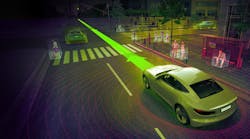Automotive racing was once the arena in which car companies showed off their engineering prowess and demonstrated the quality of their vehicles. Audiences (in person and via television) were entertained and got a somewhat superficial idea of how durable and capable certain makes and models were. Car companies also believed in the adage, “Win on Sunday, sell on Monday,” and saw racing as another way to test new ideas, market their brands, and, most importantly, bring potential buyers into their showrooms.
In keeping with that spirit, I’d like to propose a race between autonomous cars. To keep it simple, at least for the first iteration, it could be 200 miles long on an oval course; the Indianapolis Speedway would do. The race would be a competition between the self-driving systems each car used, not the horsepower, aerodynamics, and how light you could make the vehicle. Therefore, cars would be roughly the same size, weight, and power.
Each team could use whatever sensors and hardware they could design, build, or buy, and all the controlling software would have to be contained in the car on a computer about as capable as the average desktop/laptop available today, nothing exotic like a Cray in a trailer. To keep the cars resembling what people might actually buy, there would have to be room for at least a driver and passenger, and controls so a person could drive it.
The race would be open to companies, including automotive companies, and colleges, as well as private individuals and groups, with perhaps different classes so that those with deep pockets did not compete against those working on a shoestring. And the purse should be considerable, just to keep it exciting.
Race rules could be added to increase the difficulty level. For example, cars could be limited to a four-gallon gas tank, so each car’s computer controller would have to determine if and when to take a pit stop. Or the gas-tank limit might give an advantage to electric cars.
It would also be interesting if half the race could take place in a rainstorm, a test of the car’s detection subsystems and driving skills. Perhaps scheduling the race so that a good portion of it took place after sunset and in the dark would be more predictable than hoping for rain. Racing through sunset and at night would present a real-world challenge the cars’ detection subsystems. But nighttime racing might make it tough to really see the action from the stands. TV coverage could keep viewers aware of what was happening even in the dark. The cars would have headlights, after all.
The goal would be to see how various robotic cars performed in an uncontrolled environment in which human life and limb were not at risk. The public would be interested in such a race and watching the technology they’ve heard so much about being put to the test. It wouldn’t surprise me if the autonomous race would earn higher TV ratings than the Indy, especially for the first one or two.
It would also be interesting to see how car builders met the challenge: Would cars just be programmed to go as fast as possible and avoid other cars? Or would some software savant figure out how to instill an artificial sense of competition or software that “learned” and got better after it raced or practiced more often? Would cars intentionally draft or bump each other? And would you tune in and watch?

